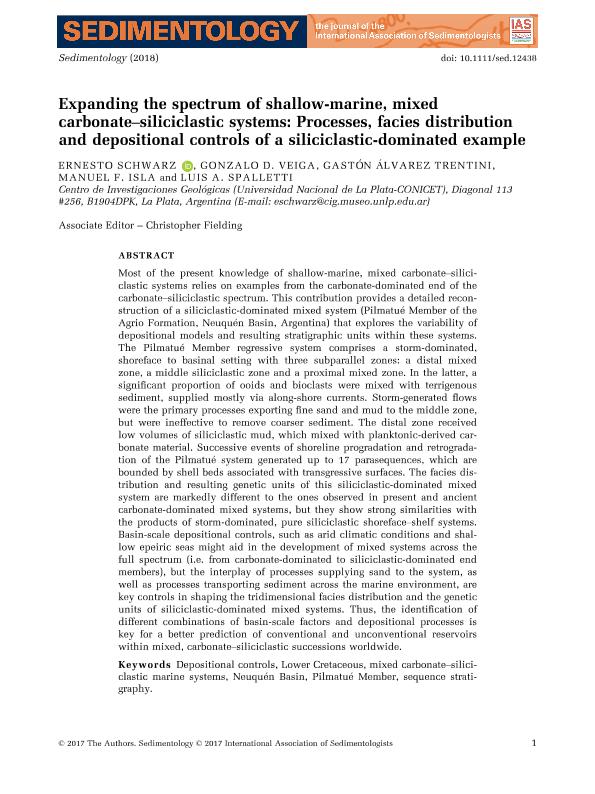Mostrar el registro sencillo del ítem
dc.contributor.author
Schwarz, Ernesto

dc.contributor.author
Veiga, Gonzalo Diego

dc.contributor.author
Álvarez Trentini, Gastón

dc.contributor.author
Isla, Manuel Fermín

dc.contributor.author
Spalletti, Luis Antonio

dc.date.available
2019-09-05T20:09:31Z
dc.date.issued
2018-08
dc.identifier.citation
Schwarz, Ernesto; Veiga, Gonzalo Diego; Álvarez Trentini, Gastón; Isla, Manuel Fermín; Spalletti, Luis Antonio; Expanding the spectrum of shallow-marine, mixed carbonate–siliciclastic systems: Processes, facies distribution and depositional controls of a siliciclastic-dominated example; Wiley Blackwell Publishing, Inc; Sedimentology; 65; 5; 8-2018; 1558-1589
dc.identifier.issn
0037-0746
dc.identifier.uri
http://hdl.handle.net/11336/82994
dc.description.abstract
Most of the present knowledge of shallow-marine, mixed carbonate–siliciclastic systems relies on examples from the carbonate-dominated end of the carbonate–siliciclastic spectrum. This contribution provides a detailed reconstruction of a siliciclastic-dominated mixed system (Pilmatué Member of the Agrio Formation, Neuquén Basin, Argentina) that explores the variability of depositional models and resulting stratigraphic units within these systems. The Pilmatué Member regressive system comprises a storm-dominated, shoreface to basinal setting with three subparallel zones: a distal mixed zone, a middle siliciclastic zone and a proximal mixed zone. In the latter, a significant proportion of ooids and bioclasts were mixed with terrigenous sediment, supplied mostly via along-shore currents. Storm-generated flows were the primary processes exporting fine sand and mud to the middle zone, but were ineffective to remove coarser sediment. The distal zone received low volumes of siliciclastic mud, which mixed with planktonic-derived carbonate material. Successive events of shoreline progradation and retrogradation of the Pilmatué system generated up to 17 parasequences, which are bounded by shell beds associated with transgressive surfaces. The facies distribution and resulting genetic units of this siliciclastic-dominated mixed system are markedly different to the ones observed in present and ancient carbonate-dominated mixed systems, but they show strong similarities with the products of storm-dominated, pure siliciclastic shoreface–shelf systems. Basin-scale depositional controls, such as arid climatic conditions and shallow epeiric seas might aid in the development of mixed systems across the full spectrum (i.e. from carbonate-dominated to siliciclastic-dominated end members), but the interplay of processes supplying sand to the system, as well as processes transporting sediment across the marine environment, are key controls in shaping the tridimensional facies distribution and the genetic units of siliciclastic-dominated mixed systems. Thus, the identification of different combinations of basin-scale factors and depositional processes is key for a better prediction of conventional and unconventional reservoirs within mixed, carbonate–siliciclastic successions worldwide.
dc.format
application/pdf
dc.language.iso
eng
dc.publisher
Wiley Blackwell Publishing, Inc

dc.rights
info:eu-repo/semantics/openAccess
dc.rights.uri
https://creativecommons.org/licenses/by-nc-sa/2.5/ar/
dc.subject
Depositional Controls
dc.subject
Lower Cretaceous
dc.subject
Mixed Carbonate–Siliciclastic Marine Systems
dc.subject
Neuquén Basin
dc.subject
Pilmatué Member
dc.subject
Sequence Stratigraphy
dc.subject.classification
Geología

dc.subject.classification
Ciencias de la Tierra y relacionadas con el Medio Ambiente

dc.subject.classification
CIENCIAS NATURALES Y EXACTAS

dc.title
Expanding the spectrum of shallow-marine, mixed carbonate–siliciclastic systems: Processes, facies distribution and depositional controls of a siliciclastic-dominated example
dc.type
info:eu-repo/semantics/article
dc.type
info:ar-repo/semantics/artículo
dc.type
info:eu-repo/semantics/publishedVersion
dc.date.updated
2019-09-04T20:03:41Z
dc.journal.volume
65
dc.journal.number
5
dc.journal.pagination
1558-1589
dc.journal.pais
Reino Unido

dc.journal.ciudad
Londres
dc.description.fil
Fil: Schwarz, Ernesto. Consejo Nacional de Investigaciones Científicas y Técnicas. Centro Científico Tecnológico Conicet - La Plata. Centro de Investigaciones Geológicas. Universidad Nacional de La Plata. Facultad de Ciencias Naturales y Museo. Centro de Investigaciones Geológicas; Argentina
dc.description.fil
Fil: Veiga, Gonzalo Diego. Consejo Nacional de Investigaciones Científicas y Técnicas. Centro Científico Tecnológico Conicet - La Plata. Centro de Investigaciones Geológicas. Universidad Nacional de La Plata. Facultad de Ciencias Naturales y Museo. Centro de Investigaciones Geológicas; Argentina
dc.description.fil
Fil: Álvarez Trentini, Gastón. Consejo Nacional de Investigaciones Científicas y Técnicas. Centro Científico Tecnológico Conicet - La Plata. Centro de Investigaciones Geológicas. Universidad Nacional de La Plata. Facultad de Ciencias Naturales y Museo. Centro de Investigaciones Geológicas; Argentina
dc.description.fil
Fil: Isla, Manuel Fermín. Consejo Nacional de Investigaciones Científicas y Técnicas. Centro Científico Tecnológico Conicet - La Plata. Centro de Investigaciones Geológicas. Universidad Nacional de La Plata. Facultad de Ciencias Naturales y Museo. Centro de Investigaciones Geológicas; Argentina
dc.description.fil
Fil: Spalletti, Luis Antonio. Consejo Nacional de Investigaciones Científicas y Técnicas. Centro Científico Tecnológico Conicet - La Plata. Centro de Investigaciones Geológicas. Universidad Nacional de La Plata. Facultad de Ciencias Naturales y Museo. Centro de Investigaciones Geológicas; Argentina
dc.journal.title
Sedimentology

dc.relation.alternativeid
info:eu-repo/semantics/altIdentifier/doi/http://dx.doi.org/10.1111/sed.12438
dc.relation.alternativeid
info:eu-repo/semantics/altIdentifier/url/https://onlinelibrary.wiley.com/doi/full/10.1111/sed.12438
Archivos asociados
